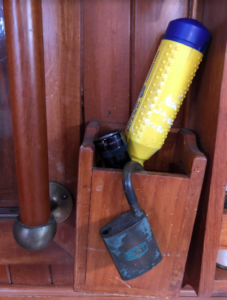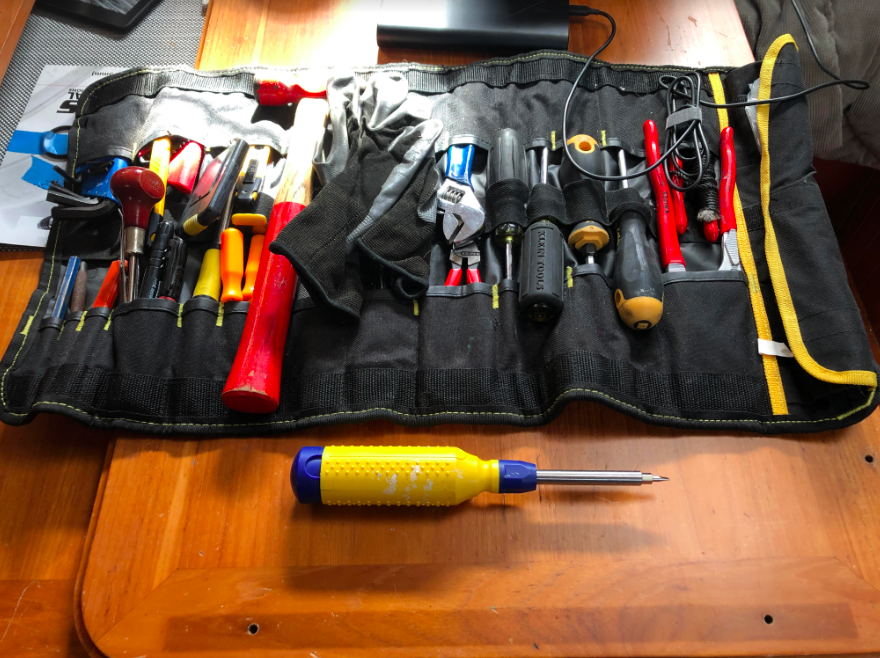In Marty McOmber’s latest column, he gives props to an indispensable tool that is a jack of all trades aboard.
One of the most important pieces of equipment aboard our boat has proven itself time and time again — so much so that it sits just next to the companionway, ready for deployment at a moment’s notice.
It’s a critical piece of safety gear, one I would personally never leave the dock without. It has prevented disasters and mishaps, and saved the day in ways large and small more times than I can count. It can even help open a jar of pickles.
It requires no batteries, no stops at the fuel dock, no complicated and expensive installations. Heck, there is no real maintenance required other than to not drop it over the side. And it will take years and years of abuse without complaint.
I value it so much that I give one to friends as boat-warming presents. And best of all, it costs about $20.
So what is this magical item? It’s a multibit screwdriver — in our particular case, the MegaPro 151SS 15-in-1 stainless steel screwdriver. Although there are tons of similar drivers gracing the countertops of hardware stores across the country, there is something about this one that makes it especially useful aboard.
Although there are tons of similar drivers gracing the countertops of hardware stores across the country, there is something about this one that makes it especially useful aboard.
Spending any significant amount of time on a boat requires fixing something on that boat. Even if your vessel is built to withstand waves bigger than a Costco, you quickly learn that it is actually held together mostly with screws. Big screws. Little tiny screws. Phillips head screws. Square drive screws. Torx screws. And worst of all, slotted screws.
Screws can make or break a boat — and possibly your arms, legs and skull.
Like the other day, when I lifted the heavy, teak companionway steps to get access to our under-cockpit space, I noticed that a couple of the screws securing the beefy bronze hinges had started to back out. In a flash, I could see the 50 pounds of teak steps crashing down on me as I crawled out of the hold — all blood and gore and cries of anguish.
But with my trusty multibit screwdriver within reach, the problem was solved almost before the swear word I had muttered when I noticed the issue had fully dissolved in the air.
I like things that can do more than one job. So having a screwdriver that can handle many different types of screws onboard provides me with a zen-like pleasure.
And it helps that, as far a tool goes, this one is really good-looking. Its bright yellow handle and blue top remind me of the Swedish flag that my mom proudly adorned our home with when I was young. I love the percussive “thwump” when you pull up the top of the handle to reveal the hidden bit holder. Maybe it’s a little compulsive, but I get a twinge of delight to see each of the bits secured in their rightful nest, save for the one that is in use.
You just never know when that screwdriver will come in handy. In the dink last summer, I noticed a funny little screw rolling between my feet. I picked it up, gave a close inspection, and decided I had no clue where it belonged. Did someone toss it in my dink? Did it fall off the boat?
I quickly dismissed the fleeting thought about tossing it over my shoulder and getting on with my life. Nope, it might be a small, short screw but, if I’ve learned anything about boats, that cheeky little screw had an important job to do and I would find out about it one way or another. So I stuck the screw in my pocket, grabbed the outboard’s throttle and effortlessly pulled the whole assembly right off.
I quickly deduced the purpose of that little screw (and, as it turns out, two more devious companions who had acquired better hiding places in the dink). A polite request for Deborah to hand me down the multibit screwdriver and the throttle was firmly back where it belonged and I was off to check the crab pots.
There are, of course, limits to what this wonderful little device can do. I still carry a full range of specific screwdrivers aboard the boat as well. Because the more you screw around with screws, you realize not one device can do it all.

If the job is in a tight space, the handle, in which the various bits are stored, can be too thick. And if the screw in question is a big one requiring a lot of torque, you need to call in a solid, hefty driver to ensure the proper amount of persuasion (and expletives) can be applied.
But nine times out of ten, that well-worn, go-to, multibit driver is just the thing.
So there it sits after years of use, its bright yellow handle still showing through the dirt smudges and white polysulfide fingerprints of some now forgotten installation or other.
Boats may come or go in our lives. But that little screwdriver is here for the long haul.






